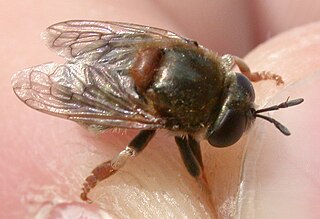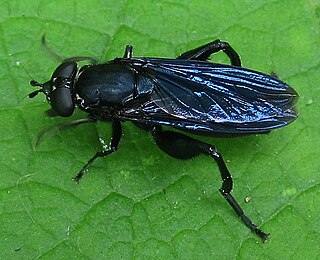
Eristalis is a large genus of hoverflies, family Syrphidae, in the order Diptera. Several species are known as drone flies because they bear a resemblance to honeybee drones.

The subfamily Microdontinae contains slightly more than 400 species of hoverflies and, while diverse, these species share several characteristics by which they differ from other syrphids. The Microdontinae are myrmecophiles, meaning they live in the nests of ants. Larval Microdontinae are scavengers or predators in ant nests, and, in contrast to other syrphid larvae, have no readily apparent body segmentation. Some species also do not exhibit the typical adult flower-visiting behaviour of other hoverflies, but instead remain near their larval host colonies.

Xylota is a Holarctic genus of hoverflies similar in structure to the related genera Chalcosyrphus and Brachypalpoides. As the larvae are saprophytic they're usually found in rotting wood. The adult flies are generally associated with woodland and woodland edges and can often be seen running over the upper sides of leaves. Unlike other syrphids the adults of many species rarely visit flowers preferring instead to gather pollen from leaf surfaces. There are over 100 described species of which 12 can be found in Europe. Seven species have been recorded in Britain. Identification of species has been difficult and identifiction by photographs is risky.

Chalcosyrphus is a genus of hoverflies in the subfamily Eristalinae. Many species exhibit some degree of mimicry of various sawflies and other hymenopterans and are often brightly coloured or metallic in hue. The adults are similar in structure and behavior to the related genus Xylota but differ in larval morphology. They can be found throughout Europe, Asia, and North America and seem to prefer damper, boggy habitats. The larvae are saproxylic feeders in rotten wood in these habitats.

Sphegina is a genus of small, slender hoverflies. They are widespread throughout Eurasia and North America. In flight they seem to have long hind legs which they often carry hanging down, making them resemble sphecid or ichneumonid wasps. Adult Sphegina are usually found in damp and shady habitats close to water in forested areas, and several species can often be found together. They often feed on white and yellow flowers of Apiaceae, Ranunculaceae, Asteraceae, and Rosaceae like Crataegus, Sorbus, and Sorbaria. Larvae nest in the sap of living and dead trees or in decaying cambium under tree bark lying in water or other damp conditions. The larvae of some species have been discovered in the tunnels of other xylophagous insects.
Archimicrodon is a genus of hoverflies. Many of the species in this genus were moved from Microdon by Reemer & Ståhls (2013). Previously, it had been described as having three known species.
Paramixogaster is a genus of hoverflies, with 25 known species. Paramixogaster has an appendix on vein R4+5 that is absent in Mixogaster.
Spheginobaccha is a genus of hoverflies, with 15 known species. The genus is readily separated from other microdons by the incomplete metathoracic bridge, round/oval basoflagellomere, occiput with a dorsolateral crease, and other characters.

The Milesiini is a large and diverse tribe of hoverflies. They mimic wasps or hornets.

Milesia is a genus of very large hoverflies, which mimic social wasps. For example, the European species Milesia crabroniformis is a convincing mimic of the hornet species Vespa crabro. Milesia are predominantly Palaeotropical in distribution almost entirely Oriental.
Dolichogyna is a genus of hoverflies.
Meropidia is a genus of hoverflies in the subfamily Eristalinae.
Meropidia rufa is a species of hoverfly in the family Syrphidae.
Nepenthosyrphus capitatus is a species of hoverfly in the family Syrphidae.
Nepenthosyrphus malayanus is a species of hoverfly in the family Syrphidae.
Nepenthosyrphus venustus is a species of hoverfly in the family Syrphidae.
Nepenthosyrphus meijerei is a species of hoverfly in the family Syrphidae.
Nepenthosyrphus oudemansi is a species of hoverfly in the family Syrphidae.
Sterphus is a genus of hoverflies.





